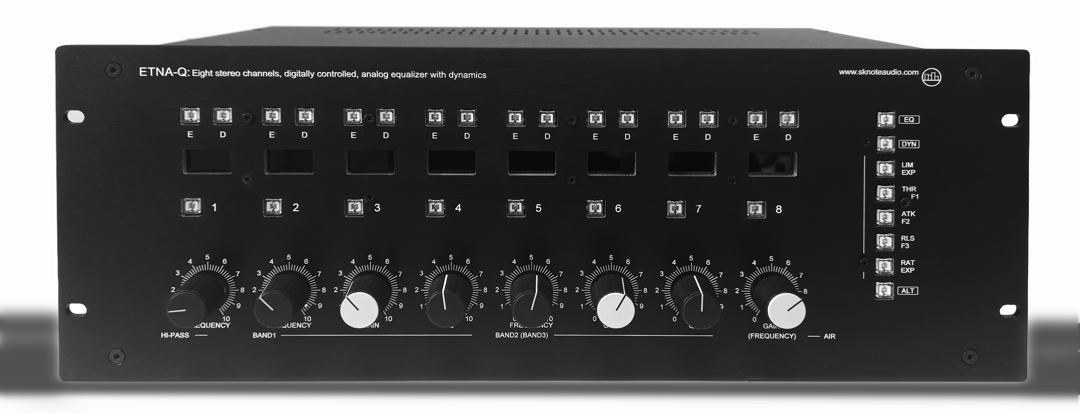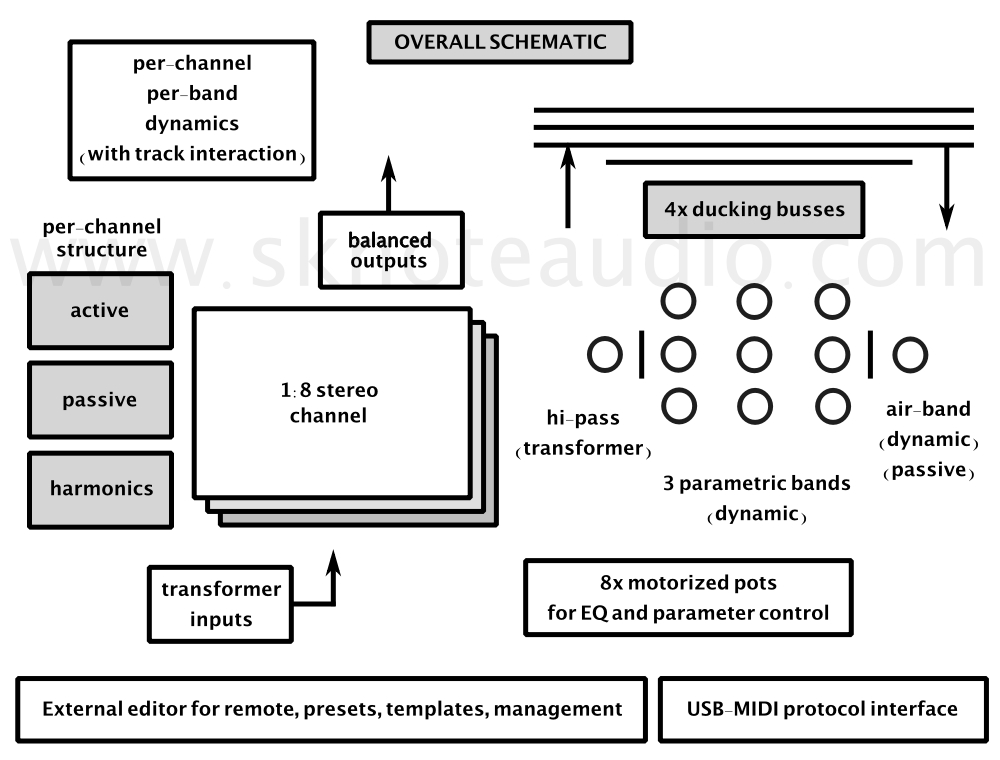
A full-analog audio path, through Blackmer VCAs, with balanced inputs and outputs.
Eight motorised pots for parameter control.
Total recall, external interface/editor, MIDI standard interface.
Full dynamic option (EQ curve reacts to level) on each stereo channel.
Mixed passive-active structure (per channel).
Four “ducking” busses for unique interaction among tracks and bands, in any combination.
This is NOT only a perfect complement to Etna-M, it is also a great standalone unit.
Total recall makes it the perfect tool for analog processing/mixing/summing with a DAW.
All the features, plus some additional metering, are replicated on the external editor.

The editor runs in any modern browser, being extremely lightweight and portable.
FAQ (Frequently Asked Questions)
(Additional questions: please write to sales@sknoteaudio.com)
Q.: How to buy one unit?
A.: Write to sales@sknoteaudio.com, specifying the number of units you need. Current launch price tag is 2.499 USD/euro each (VAT, taxes, shipment to be computed separately), with special price for multiple units.
Q.: Is this an option for Etna-M only?
A.: NO! This is a completely independent unit, useful to get 16 channels of total-recall EQ (and dynamic EQ) with unique features. It integrates perfectly with Etna-M, though.
Q.: Does the console rely on its external editor?
A.: NO. The external editor is an available option (included) that makes interacting with a modern DAW (Digital Audio Workstation) simpler. The console is a completely independent hardware device.
Q.: Is the audio being converted to digital?
A: NO. The audio path is completely analog, through VCAs (Voltage Controlled Amplifiers).
Q.: There is software involved. How can I ensure my investment is safe in the long term?
A.: The unit is completely self-contained. Switch it on and go. Any interfacing to software world is done through classic, well-established standards (MIDI, Mackie Control Protocol) so it is easily accessible from any compatible system like any modern DAW. Also, we’ve been in the hardware audio world for several years, now, including lots of places where you can’t see us. You can always contact us.
Q.: I read “8 x stereo channels”. What about mono channels?
A.: You can use any channel as mono, of course. We usually use a couple of D/A (Digital to Analog) converters for that (so, a stereo channel for a mono source, too), because it lets us manage the panning from inside the DAW. But that’s up to you.
Q.: What if I need more than 8 stereo channels today or will need more tomorrow?
A.: More units can be used. Get two (or more) or add one later.
Q.: What about assistance?
A.: The unit is deeply modular inside and uses well diffused components. It usually is just about replacing a module and diagnosis is very simple. We offer direct assistance here (by shipment, like with our previous devices) and are working with distributors to build a small network of assistance points in other countries.
Q.: Do I need my mouse to control parameters (e.g. compressor attack on channel 3)?
A.: NO! The faders control ALL the parameters and provide (together with the screens) visual feedback. But you CAN use it if you like, by opening the editor. The editor is REALTIME. So you can. for example, move a fader also from there while programming automation.
Q.: How big is an unit?
A.: You can easily refer to the sizes listed in the specs. In any case, it is wide about like a small computer keyboard, with four rack units front-plate height. It is available with or without rack wings.
Q.: Do you only sell direct?
A.: Today: yes. Tomorrow: no. After a total stop due to lock-down times, we restarted with hardware from scratch, re-defined the management (including deals and solid partnerships) and decided to start from scratch with distributors. So we’ll probably go through distribution, too. The choice of purchasing directly from us or through re-sellers will be up to you. A distributor does also usually manage local assistance, though.
Q.: I love the concept but I’m a bit concerned about the price: how can you stuff all these things inside it with such a price tag?
A.: This is not black magic. It is clever design (very, if we may) and departing from old-style concepts, while getting the best out of old and well tested things like the op-amps and transformers. You get all of that but nothing is wasted. This is an unit you’ll absolutely love. Also, going direct or max through a single distribution layer helps.
Q.: Does the processing happen in the DAW?
A.: The console interfaces to the host by Mackie standard but that’s not the preferred way of using the connection for mix levels.
Using the console as a controller changes output levels through the DA converters.
The preferred way of mixing in analog world is having the DA converters to work at full range and make the levels in analog (so to keep full resolution).
So, the preferred way of dealing with mix automation is to record the MIDI messages, instead of interacting with host’s mixer. In playback, these messages will control the physical pots. Some video tutorials will make all of this quite simple.
Q.: Does the unit feel solid?
A.: The case is a powder coated steel shell. No plastic.
Q.: How is the pinout of the D-sub connectors?
A.: It follows the Tascam standard for analog audio. From pin 1, on a single line: Hot, Cold, Ground and so on. Please email if you need help with checking for your system.
Sizes: 4RU (rack units) * 24 cm deep.
Case: steel (powder-coated) and anodised aluminium.
Mains: universal.
Inputs: 8 x stereo, transformer.
Internal routing: individual ins/outs.
Outputs: 8 x stereo, electronically balanced.
VCAs: Blackmer.
Input dynamics: 24dBu.
Output dynamics: 26 dBu.
Effects: EQ and Dynamic EQ (with threshold, attack and release times, compression, limiting, expanding) on each stereo channel, for three main and “air” bands.
EQ structure: mixed active and passive.
Special features: 4 x “Ducking” busses with full connectivity.
Controls: 32 x LED-buttons, 8 x motorised pots (replicated in realtime on the external editor).
Metering/Display: 8 x graphic OLED screens.
Interface to DAW: USB/MIDI standard (Mackie).
Interface to editor: USB host.
D-sub standard: Tascam.
Distributors, re-sellers: please write to sales@sknoteaudio.com